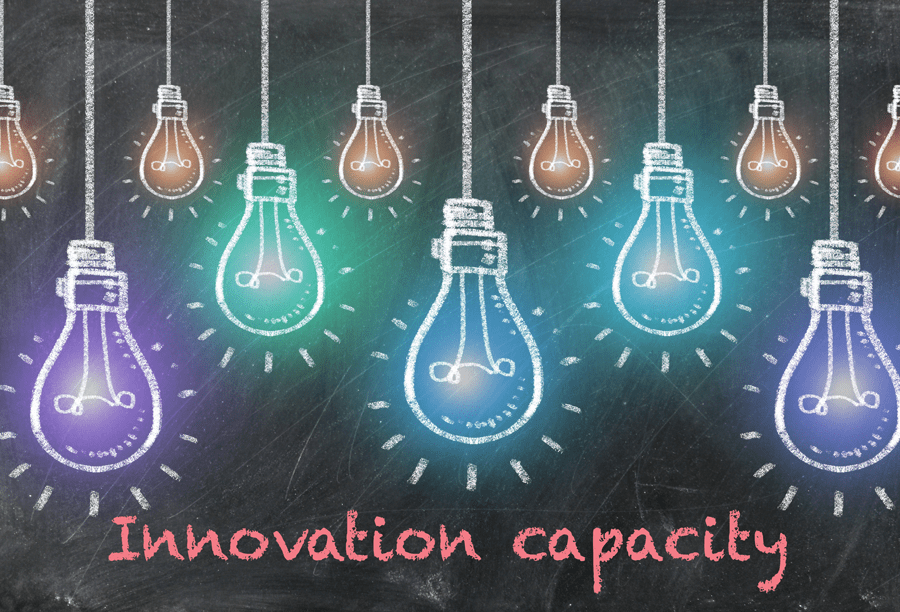Innovation capacity: how to develop it in your organisation

Innovation capacity is an important concept for any organisation or company, no matter how small or large. The question is what helps to develop greater levels of innovation capacity?
Organisations are complex amalgamations of many factors all of which have to come together to produce the outcomes the organisation desires. Research into connections between multiple factors that enhance organisational performance is particularly important as it can tell us the consequences of these mixes of factors. Working out what enhances innovation capacity is a critical issue for any organisation and a new study has found that there are important connections between:
- Innovation capacity
- Organisational learning, and
- Organisational culture
Understanding these connections can help any organisation increase its innovation capacity.
- Innovation capacity
- Open Innovation
- Organisational culture and open innovation
- Absorptive capacity
- Realised absorptive capacity and potential absorptive capacity
- Integrative open cultures
- Ability to recognise value
- Hierarchy
- Reference
Innovation capacity refers to produce and exploit new products, services or processes (ways of doing things) over long periods of time. There are three different levels of innovation capacity:
- National innovation capacity refers to a countries ability to produce and exploit new products, services, systems or processes over long periods of time.
- Industrial innovation capacity refers to the ability to produce and exploit new ideas across a range of organisations or companies in an industry, for example construction, policing, health etc.
- Organisational innovation capacity refers to a single organisation or companies capability to produce and exploit new products, services, systems or processes over periods of time.
The term open innovation basically means a situation where an organisation doesn’t just rely on their own internal knowledge, sources and resources (such as their own staff or R&D for example) for innovation (of products, services, business models and processes etc.) but also uses multiple external sources (such as customer feedback, published patents, competitors, external agencies, the public etc.) to drive innovation.
The two types of open innovation
There are considered to be two types of open innovation:
- Inbound open innovation
- Outbound open innovation.
Inbound innovation is about sourcing and acquiring expertise from outside the organisation and scanning the external environment for new information to identify, select, utilise and internalise ideas.
Outbound innovation is the purposeful commercialisation and capture of internally developed ideas in the organisation’s external environment. This might be through selective revealing of a product to journalists and reviewers or selectively selling the technology or service to customers with a view to getting feedback.
Organisational culture and open innovation
A forward thinking, outward looking culture within an organisation will allow the organisation to recognise and use knowledge outside of its immediate boundaries. To do this it has been found that the organisation needs good levels of absorptive capacity.
Free Research Briefs
Get research briefings, infographics, video research briefings and more
Absorptive capacity is an organisation’s ability to identify, assimilate, transform and use valuable external knowledge. In other words, absorptive capacity is the measure of the rate at which an organisation can learn and use scientific, technological or other knowledge that exists outside of the organisation itself. It is in effect, a measure of an organisation’s ability to learn.
There are two forms of absorptive capacity:
- Potential absorptive capacity
- Realised absorptive capacity
Realised absorptive capacity and potential absorptive capacity
Potential absorptive capacity is the process of acquiring and assimilating knowledge. Realised absorptive capacity, as the name suggests, is the ability to exploit, transform and commercialise that knowledge to create value and hopefully competitive advantage.
Integrative open cultures
The study found that ahighly integrative culture tends to welcome new ideas and knowledge from external sources, which enhancing its performance across a range of functions including sourcing, acquiring, internalising and importantly commercialising or finding competitive advantage in the new acquired knowledge.
These types of organisational culture tend to be receptive and open to new ideas and they tend to create strong connections and cultivate co-operative connections between the organisation and its external environment. This promotes the effective use and application of new ideas. Additionally this develops internal expertise and learning and focuses people inside the organisation on capitalising on new ideas both from within and without.
The organisation’s ability to recognise the value of new external information, assimilate it and apply it to commercial ends is key. An organisation is part of the environment in which it operates and should not really be trying to operate in isolation from it.
Organisations need to use external resources, to include research you will be reading in The Oxford Review, but also to make direct links with other organisations, such as universities and competitors in the industry. For example, it has been found that employees who work across different organisations often bring new ideas and practices to their parent company. The culture of that company will define whether or not such external ideas are capitalised on.
The Hottest Research Trends 2018: Analysis by The Oxford Review
The study further found that the more hierarchical an organisation is, the more there is a clear, bureaucratic adherence to roles in an organisation. These types of organisation are frequently less open to external ideas and practices in a ‘not invented here’ mentality. The knock-on effect is often that staff rarely reach out for inspiration and ideas and are largely tied up with internal concerns, politics and work. Innovation and change is usually not seen as their job. As a result these hierarchical organisations tend to be significantly less open to innovation and change, both from external and internal sources unless it is promoted through the hierarchy.
Reference – available to members (log in to see the reference)
Be impressively well informed

Get the very latest research intelligence briefings, video research briefings, infographics and more sent direct to you as they are published
Be the most impressively well-informed and up-to-date person around...



